Swansea and Mumbles Railway
History
The Swansea and Mumbles Railway began life as the curiously titled 'Oystermouth Railway or Tram Road Company', a horse-drawn, 4ft-gauge plateway using 'L'-section rails; it evolved into what was effectively a railway, using horse and steam traction, and ended up as a fully fledged electric tramway running the largest capacity tramcars ever to see the light of day in the British Isles.
The ORTRCo opened for goods business in April 1806, and a year later, on the 25th March 1807, a passenger service was instituted by one Benjamin French (paying the company for the privilege) using what seems to have been a horse-drawn carriage not unlike a stagecoach, gaining it the title, for posterity, of the world's first fare-paying, passenger carrying railway. Services seemed to have lasted until around the mid 1820s, income having been badly impacted by the construction of a turnpike which ran alongside the route of the railway. The railway had also cost more to build than the shareholders had subscribed, and loans (mortgages) were used to make-up the shortfall; a failure to repay these (and the interest due upon them) eventually led to the seizure of the assets by the mortgagees. By the mid-1850s, the plateway, which was in terrible condition, was relaid as a standard gauge railway by George Byng Morris, in order to move coal from his colliery to Swansea.
Horse-drawn passengers services, which were reintroduced in 1860, were taken over by the Swansea Improvements and Tramways Company (SI&TCo) — under a 21-year lease agreement — on the 1st of July 1877, with steam traction being introduced on the 17th August 1877. Unfortunately, Morris had previously sold the railway in 1865 to a contractor by the name of John Dickson, who subsequently entered bankruptcy before full payment was made. This was to have serious repercussions a decade later as the court dealing with Dickson's bankruptcy ordered that the sale be completed, so that it could then be resold as part of Dickson's estate, the railway duly being purchased by a local consortium at auction. This marked the start of a long and acrimonious battle between the owners over the SI&TCo's running rights, which though ultimately confirmed, meant that two companies were able to operate over the same track, the operating conditions being laid out in detail by the railway commissioners.
The railway's owners introduced their own steam services in March 1878, with the SI&TCo's steam services being withdrawn in August of the same year, and its horse services in the October (following a legal ruling). On the 31st March 1879, the local consortium owning and operating the railway was formally incorporated as the Swansea and Mumbles Railway Ltd. Following yet another legal ruling, the SI&TCo re-introduced its horse services on the 1st May 1880. In 1884, the railway leased the rights to operate their services to Sir John Jones Jenkins and Robert Capper, the latter subsequently securing a major stake in the S&MRCo. The conflict between the S&MRCo and the SI&TCo seemed to have been resolved on the 1st July 1885, when Jenkins and Capper sub-let operation to the SI&TCo, whereupon they re-introduced their steam services and withdrew the horse cars. Following expiry of the lease however, the company decided to work the steam services itself (from 1st January 1892), whereupon the SI&TCo once more re-introduced its horse services. The horse services were withdrawn for the last time on the 31st March 1896 following a financial agreement between the S&MRCo and the SI&TCo. A new company — the Mumbles Railway and Pier Company — was formed to build an extension to Mumbles, and this company formally took over operation of the railway on the 1st July 1898, even though the extension was not to open for another two years (on 26th August 1900). An agreement was struck with the SI&TCo to take over operation, which they duly did on the 1st July 1899 on a 999-year lease.
Meanwhile, the British Electric Traction Co Ltd, a concern which at its zenith either owned, part-owned or leased around 50 tramway concerns across the British Isles, had gained control of the SI&TCo (in early 1898). Although the BETCo's primary objective in acquiring tramway companies was to electrify them, it ran the S&MR for nearly 30 years before doing so, ostensibly because the case for doing so did not make compelling financial sense. The first electric tram ran on the 2nd March 1929, using high-capacity double-deck tramcars, the operating company being South Wales Transport Company Ltd, a subsidiary of the BETCo. The tramway carried very heavy loadings in summer, but by the 1950s was making significant annual losses. The SWTCo bought out the owners (the SMRCo and the MR&PCo) in September 1958, and the tramway was closed on the 5th January 1960, buses being substituted.
At its maximum extent, the Swansea and Mumbles Railway was 5.38 miles long, running from Rutland Street in Swansea, running along the curve of Swansea Bay southwestwards through Brynmill, turning southwards at Black Pill, then southeastwards at Oystermouth to the terminus at Pier Station, Mumbles. The tramway was connected to Swansea's horse tramway system at St Helens (known as the slip) and through services from Swansea to Oystermouth were operated for a short period in the horse tramway era.
Uniforms
There is no evidence that the men working the horse-drawn services were issued with uniforms, and indeed, several photographs from the 1860s have survived which clearly show that informal attire was worn. In 1877, the SI&TCo introduced the first steam-hauled services on the line, which despite the fact that it was a railway, used street tramway-like coaches and Hughes-built steam tram engines. The SI&TCo steam service lasted barely a year before being replaced by horse-drawn traction, primarily as a result of a legal challenge from the railway's new owners. Drivers working the short-lived steam services wore standard railway footplate attire, whereas conductors were issued with blue serge uniforms with red piping; jackets were double-breasted with three pairs of buttons (probably bearing the SI&TCo title and unofficial Swansea arms — see link) and lapels. Hats appear to have been in a kepi-style — it is however unclear whether they bore a badge of any description.
Shortly before the cessation of SI&TCo steam-hauled services, the newly formed Swansea and Mumbles Railway had introduced its own — although the carriages were of an unusual design, the locomotives were pure 'railway' in design. These services eventually passed into the hands of the SI&TCo in 1896, and it then operated them right through until electrification in 1929. Steam locomotive drivers and firemen, irrespective of whether they were employed by the railway (between 1877 and 1896) or the tramway company (1896 onwards) appear to have worn standard railway footplate attire, i.e., cotton jackets and trousers, along with either grease-topped or soft-topped caps, and later on flat caps. No insignia of any kind appears to have been worn on either the jackets or the caps. Although conductors working the steam services certainly wore uniforms of some description, surviving photographs do not allow any details to be discerned.
Staff working the electric services — introduced in 1929 — wore double-breasted jackets with four pairs of buttons (almost certainly the standard BETCo 'Magnet & Wheel' issue — see link) and lapels; the latter bore elaborate embroidered system initials — S&WTCo — on both sides. Caps were in a military style with a tensioned crown (top) and a glossy peak, and bore a block lettering 'SOUTH WALES' cap badge; these were probably brass initially, but at some point would have been superseded by nickel versions. Crew members were also issued with waistcoats, as well as double-breasted overcoats; the lapels of the latter once again bore 'S W T Co' initials on both sides.
With a single exception, photographs of inspectors appear not to have survived, so it is currently not possible to state what uniforms they wore. The sole surviving photo is of the SI&TCo steam tram service of 1877, and this suggests that senior staff may have worn long, single-breasted coats, along with kepi-style caps; the latter do not appear to have carried any insignia.
Female staff may have been employed during the Great War to replace male staff lost to the armed services; if so, photographs are yet to come to light.
Further reading
For a history of the Swansea and Mumbles Railway, see: 'The Swansea & Mumbles Railway' by Charles E. Lee; Oakwood Press (1988).
Images
Horse tram drivers and conductors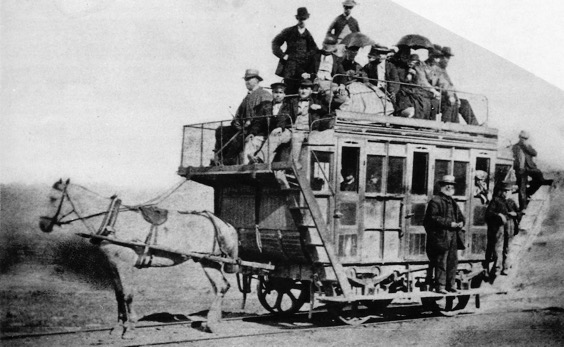
A single-horse, double-deck carriage — photo purportedly taken in 1868 when the services were provided by George Byng Morris. None of those present appear to be wearing a uniform, suggesting that informal attire was the order of the day. Photo courtesy of the Tramways and Light Railway Society, with thanks to David Voice.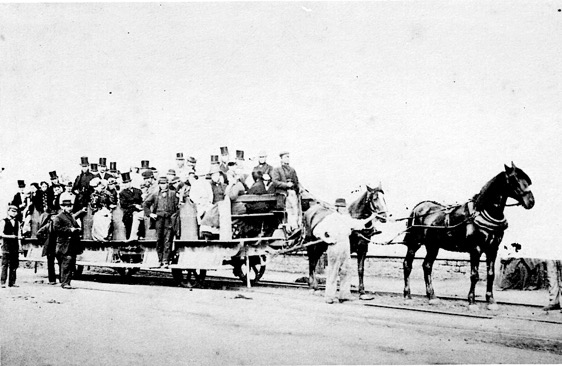
Another photo which was probably taken in the 1860s, this time of a two-horse vehicle. Photo courtesy of the Tramways and Light Railway Society, with thanks to David Voice.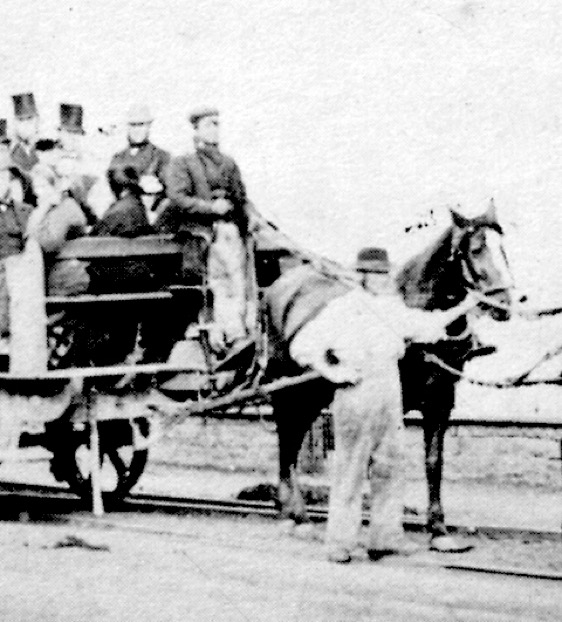
A blow-up of the above photo showing the driver and assistant, both of whom are wearing informal attire.
Steam engine drivers and conductors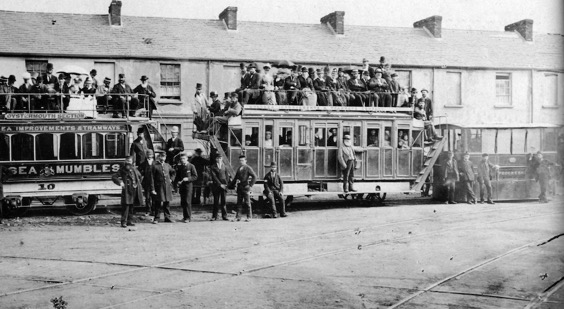
Swansea Improvements and Tramways Company Hughes Steam Tram 'Progress' at the Rutland Street terminus in 1877. SI&TCo steam-hauled services lasted barely a year before they were replaced by horse-drawn services following a legal challenge. Photo courtesy of the Tramways and Light Railway Society, with thanks to David Voice.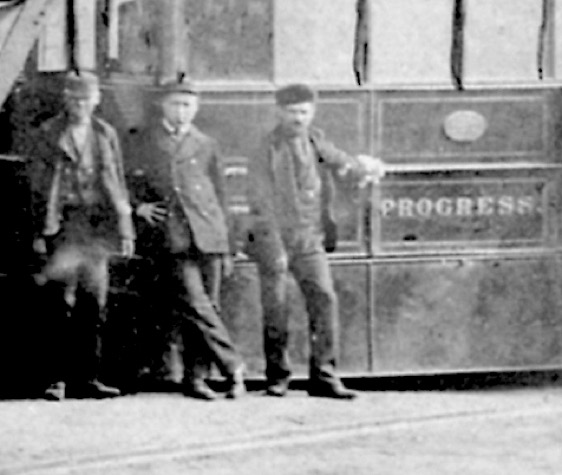
A blow-up of the above photo showing what appear to be two uniformed members of staff and the driver (right). Clearly, the SI&TCo had great ambitions for steam operation, as it seems not to have issued uniforms to its horse tram staff working the Swansea system either at this time or indeed, right through to electrification of the latter in 1900.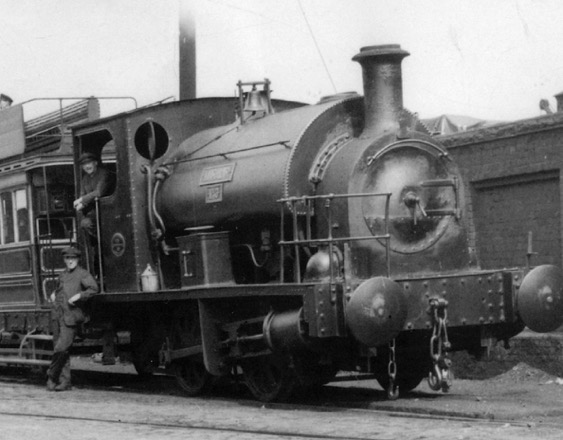
The crew of Loco No 3 pose for the camera at Rutland Street terminus in the 1920s. Both men are wearing typical steam locomotive footplate attire, seemingly devoid of insignia. Photo courtesy of the Tramways and Light Railway Society, with thanks to David Voice.
Electric tram motormen and conductors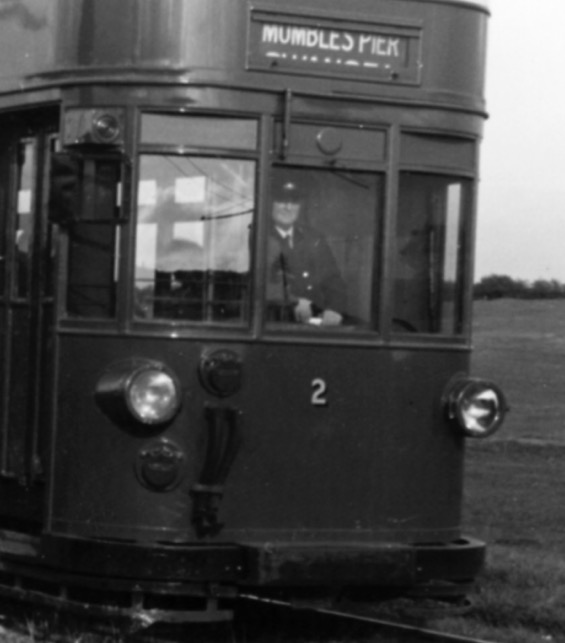
A motorman at the controls of Tramcar No 2 on a service to Mumbles Pier — photo undated, but probably taken in the 1950s. The motorman is wearing the standard South Wales Transport cap badge. Photo courtesy of the Tramways and Light Railway Society, with thanks to David Voice.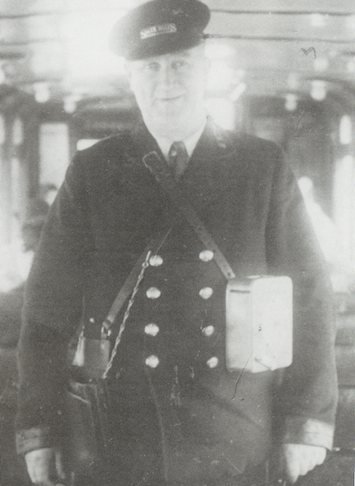
A poor-quality photo, but one which does show the South Wales Transport Company cap badge reasonably clearly — photo undated, but probably taken in the 1950s. The conductor is believed to be Bill Allsopp; photo courtesy of the Stephen Howarth Collection.
South Wales Transport Company cap badge — brass. These were probably worn from the start of electric services in 1929, but may at some point have been superseded by nickel versions, though this is currently unproven. Author's Collection.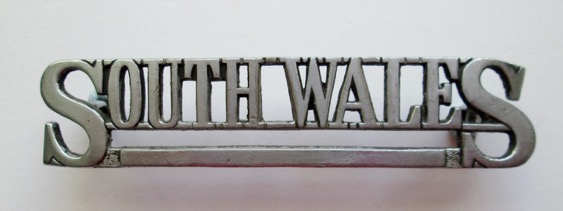
South Wales Transport Company cap badge — nickel. Stephen Howarth Collection.
Senior staff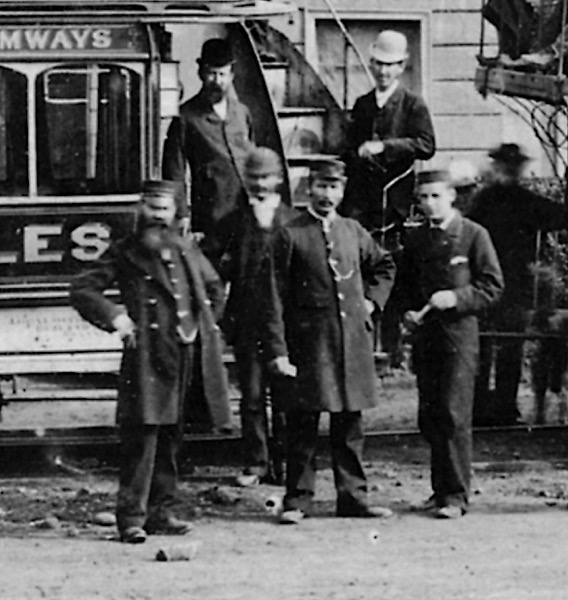
A blow-up of the 1877 SI&TCo steam tram photo above, showing two rather proprietorial-looking gentlemen, who may well be inspectors.